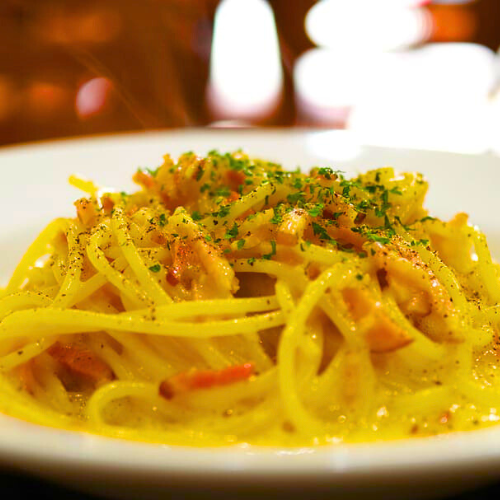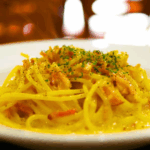What Are the 4 Ingredients in Carbonara? | The Ultimate Guide to Authentic Carbonara
What Are the 4 Ingredients in Carbonara? Carbonara is one of Italy’s most beloved pasta dishes, famous for its simplicity and rich, savory flavor. But despite its widespread popularity, there’s often confusion about what truly makes a carbonara authentic. So, what are the 4 ingredients in carbonara?
The answer is simple: guanciale, Pecorino Romano, eggs, and pasta. These four ingredients create the foundation of this iconic Roman dish.
In this comprehensive guide, we will explore each ingredient in detail, discuss their traditional roles, provide expert tips on how to use them, and debunk common myths surrounding carbonara. By the end of this article, you’ll know exactly what makes a perfect carbonara and how to prepare it like a true Italian chef.
Table of Contents
- Introduction to Carbonara
- What Are the 4 Ingredients in Carbonara?
- Optional Ingredients: What’s Allowed and What’s Not?
- How to Make Authentic Carbonara: Step-by-Step Guide
- Common Mistakes to Avoid
- Nutritional Information
- The History of Carbonara
- FAQ: Carbonara Questions Answered
- Conclusion
Introduction to Carbonara
Carbonara is a traditional Roman pasta dish that showcases the beauty of simplicity. With only four core ingredients, it’s a testament to the Italian culinary philosophy: using a few high-quality ingredients to create a masterpiece.
Unlike many other pasta dishes, carbonara does not use cream, garlic, onions, or butter. Its luxurious texture and savory flavor come solely from the interaction between cured pork, aged cheese, eggs, and perfectly cooked pasta.
Understanding what are the 4 ingredients in carbonara is crucial to mastering this dish.
What Are the 4 Ingredients in Carbonara?
Let’s dive into each ingredient and understand why it is essential to the authenticity of carbonara.
1. Guanciale
Guanciale is an Italian cured meat made from pork jowl or cheek. It is the first and most important ingredient in carbonara.
Why Guanciale?
- Guanciale is prized for its high-fat content and intense flavor.
- When cooked, it renders delicious fat that coats the pasta and adds a deep, savory richness.
- Unlike pancetta or bacon, guanciale has a unique texture and aroma that define authentic carbonara.
Substitutions:
While pancetta or bacon can be used in non-traditional versions, purists insist that only guanciale provides the authentic Roman flavor.
How to Prepare Guanciale for Carbonara:
- Cut into small strips or cubes.
- Slowly render over low heat until crispy and golden but not burned.
- Reserve the fat to coat the pasta later.
2. Pecorino Romano
Pecorino Romano is a hard, salty Italian cheese made from sheep’s milk.
Why Pecorino Romano?
- It contributes sharpness and saltiness to balance the richness of the guanciale and eggs.
- Its granular texture helps it melt smoothly into the pasta.
- Aged for at least five months, it provides a distinctive flavor essential to carbonara.
Substitutions:
Some recipes use Parmesan (Parmigiano-Reggiano), but traditionalists insist on Pecorino Romano for its bold, tangy flavor.
How to Use:
- Grate finely for easy melting.
- Combine with beaten eggs to create the creamy sauce.
3. Eggs
Eggs are the secret to carbonara’s velvety, creamy texture without the use of cream.
Why Eggs?
- The egg yolks bind the cheese and pork fat to the pasta, creating a luxurious sauce.
- Traditionally, whole eggs and/or additional yolks are used to achieve the desired creaminess.
Substitutions:
There are no real substitutes for eggs in carbonara. They are essential for the structure and texture of the dish.
How to Use:
- Beat eggs in a bowl with grated Pecorino Romano.
- Toss with the hot pasta off the heat to prevent scrambling.
Typical Ratio:
- For 400 grams of pasta: 2 whole eggs + 2 yolks.
4. Pasta
The fourth and final ingredient is pasta. The type of pasta is crucial in achieving the right texture and sauce adherence.
Which Pasta?
- Spaghetti is the most traditional choice.
- Other common options: rigatoni, bucatini, or tonnarelli.
Why Spaghetti?
- Its smooth surface allows the sauce to coat each strand evenly.
- The simplicity of the shape complements the complex flavors of the other ingredients.
Cooking Tips:
- Cook until al dente.
- Reserve some pasta water to help emulsify the sauce.
Optional Ingredients: What’s Allowed and What’s Not?
One of the most common misconceptions about carbonara is the inclusion of non-traditional ingredients. Let’s set the record straight.
| Ingredient | Traditional? | Why/Why Not |
|---|---|---|
| Cream | ❌ No | Cream is never used in authentic carbonara. The sauce is made from eggs and cheese. |
| Garlic | ❌ No | Not part of the traditional recipe, though some modern versions add it. |
| Onion | ❌ No | Similarly, not authentic. The flavor should come from guanciale. |
| Black Pepper | ✅ Yes | Considered an optional but traditional addition, enhancing flavor. |
| Olive Oil | ❌ No | Guanciale provides sufficient fat for cooking. |
| Butter | ❌ No | Not needed and not traditional. |
So, while some recipes may include cream or garlic, an authentic carbonara relies solely on the four core ingredients plus black pepper.
How to Make Authentic Carbonara: Step-by-Step Guide
Here’s how to prepare traditional carbonara using only the four essential ingredients.
Ingredients:
- 400g spaghetti
- 150g guanciale
- 100g Pecorino Romano, finely grated
- 2 whole eggs + 2 yolks
- Freshly ground black pepper (optional)
Instructions:
- Prepare the Guanciale:
Cut the guanciale into small strips. In a cold pan, place the guanciale and slowly render over low heat until golden and crispy. Remove from heat, reserving the fat. - Cook the Pasta:
Boil spaghetti in salted water until al dente. Reserve 1 cup of pasta water. - Make the Sauce:
In a bowl, beat the eggs and yolks with the grated Pecorino Romano. Add a generous amount of black pepper if desired. - Combine:
Add the hot pasta to the guanciale and toss to coat in the fat. Remove from heat. Add the egg-cheese mixture and toss vigorously, adding reserved pasta water as needed to create a creamy, smooth sauce. - Serve:
Plate immediately with a final sprinkle of Pecorino Romano and black pepper.
Common Mistakes to Avoid
❌ Adding Cream
Authentic carbonara is creamy from eggs and cheese, not dairy cream.
❌ Overcooking the Eggs
Always combine the egg mixture off the heat to prevent scrambling.
❌ Using the Wrong Pork
Bacon or pancetta lacks the distinctive flavor of guanciale.
❌ Forgetting Pasta Water
The starchy water helps emulsify the sauce.
❌ Skipping the Cheese Quality
Use only high-quality Pecorino Romano.
Nutritional Information
| Nutrient | Per Serving (approx.) |
|---|---|
| Calories | 600-700 kcal |
| Protein | 25-30g |
| Fat | 35-40g |
| Carbs | 50-60g |
Note: Nutritional values vary depending on portion size and ingredient brands.
The History of Carbonara
Carbonara’s exact origins are debated, but most food historians agree it developed in Rome during the mid-20th century.
Possible Origins:
- Coal Miners’ Pasta: Some claim the name derives from “carbonari” (charcoal burners) who made a simple pasta with eggs and cheese.
- American Influence: Others suggest American soldiers introduced bacon and eggs to Italy during WWII, inspiring Roman cooks to create carbonara.
Regardless of its origins, carbonara has become a quintessential Roman dish, respected globally for its simplicity and flavor.
FAQ: Carbonara Questions Answered
❓ What are the 4 ingredients in carbonara?
The four traditional ingredients in carbonara are guanciale, Pecorino Romano, eggs, and pasta.
❓ Is garlic used in traditional carbonara?
No, garlic is not part of authentic carbonara. Traditional recipes rely on the flavor of guanciale.
❓ Can I use bacon instead of guanciale?
While some recipes use bacon or pancetta, authentic carbonara calls for guanciale due to its unique texture and flavor.
❓ Is cream ever added to carbonara?
No, cream is not used in traditional carbonara. The creamy texture comes from eggs and cheese.
❓ What kind of pasta is best for carbonara?
Spaghetti is the most traditional, but rigatoni, bucatini, and tonnarelli are also acceptable.
❓ How do I prevent the eggs from scrambling?
Always mix the eggs and cheese with the pasta off the heat and toss vigorously, adding pasta water to adjust the consistency.
❓ Is Pecorino Romano necessary, or can I use Parmesan?
While some may substitute Parmesan, Pecorino Romano is traditional and provides the characteristic sharp, salty flavor.
❓ Can I make carbonara without pork for a vegetarian version?
While traditional carbonara relies on guanciale, some create vegetarian versions using mushrooms or smoked cheese, but these are not considered authentic.
❓ What is the origin of the name “carbonara”?
It likely comes from “carbonari” (charcoal burners) or from the dish’s pepper-speckled appearance resembling coal dust.
❓ How do Italians feel about cream in carbonara?
Most Italians consider the addition of cream a culinary crime. Authentic carbonara is made without cream.
Conclusion
Now you know the definitive answer to “What are the 4 ingredients in carbonara?”: guanciale, Pecorino Romano, eggs, and pasta. This classic Roman dish is all about simplicity, technique, and respect for tradition.
By focusing on these four ingredients and mastering the preparation method, you can enjoy one of Italy’s most iconic pasta dishes at home. Whether you’re an amateur cook or a seasoned chef, understanding the true essence of carbonara will deepen your appreciation for Italian cuisine.
Buon appetito!
Meta Description (SEO Optimized):
Discover what are the 4 ingredients in carbonara, learn how to make authentic Italian carbonara, and find answers to all your carbonara-related questions in this ultimate guide.
Suggested Internal Links (for better SEO):
- The Difference Between Pancetta and Guanciale
- 10 Common Pasta Mistakes and How to Avoid Them
- Authentic Italian Pasta Recipes
- How to Grate Cheese Perfectly




